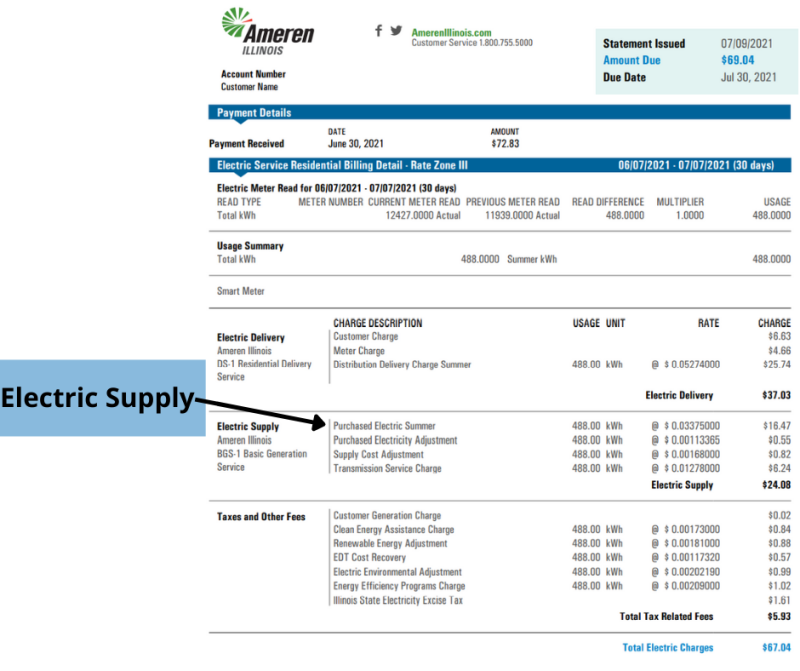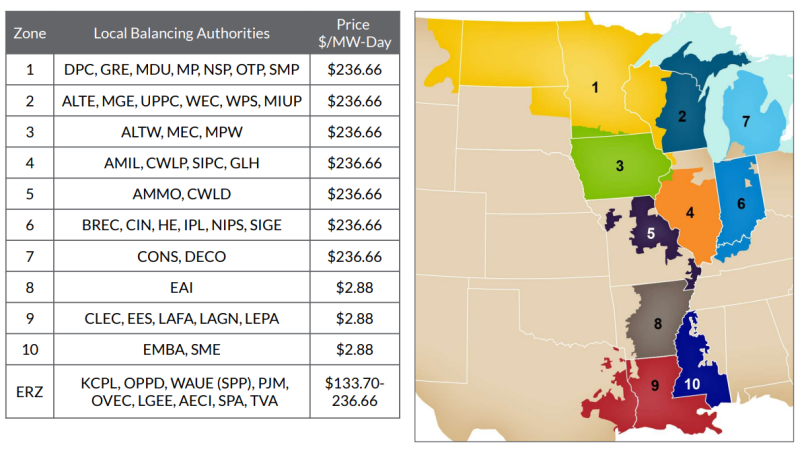What’s happening to Ameren customers?
Since June 1, 2022, the price for electricity has more than doubled for Ameren customers across Central and Southern Illinois, and that’s expected to cost customers hundreds of dollars in higher power bills over the next year.
What is Ameren’s electricity price?
As of Jan. 1, 2023, Ameren’s “price to compare”–the supply rate you compare with alternative supplier offers–is:
- 0-800 kilowatt-hours (kWh): 11.833¢ per kWh
- Above 800 kWh: 9.374¢ per kWh
For the first 800 kilowatt-hours, this represents a 116 percent increase over the price last January. The “price to compare” includes the supply price, a transmission charge and a supply cost adjustment. This rate is in effect through May 31, 2023.

The price we pay for electricity (the charge labeled “Purchased Electric Summer/Non-summer”) went up significantly on June 1. (Note: This is a bill from 2021, so the prices are outdated.)
How much will this price spike cost me?
When Ameren’s supply price first skyrocketed in June, Ameren said: “The typical Ameren Illinois residential customer will see a $626 annual increase on the power supply side of the bill or an average of $52 or more per month throughout the year.” The increase could be even more for electric heat customers.
What part of my electric bill is affected?
This impacts the supply portion of bills, what we pay for the actual electricity. The supply cost takes up half to two-thirds of electric bills.
Ameren Illinois, the electric utility in Central and Southern Illinois, is only responsible for delivery and not supply. Thus, it does not profit off the supply portion of bills–Ameren simply passes along what they pay for supply, with no markup.
How long will prices stay elevated?
At least through May 31, 2023, and it could be longer. We don’t know exactly when energy markets will stabilize.
Why is this price spike happening?
This is related to several factors, many of which have impacted energy markets across the world.
- Natural gas prices have been at extremely high levels for more than a year because of multiple factors, including, most recently, the Russian invasion of Ukraine. The high gas prices have now led to high electricity prices–because natural gas is often used to generate power.
-

Capacity costs–what we pay power plant operators to have adequate reserve electricity–skyrocketed in an April auction held by the power grid operator for Central and Southern Illinois, which is in Zone 4. These capacity costs are wrapped into the price we pay for electricity and are a major reason for the June 1 price spike.
Adding to the high energy price is a recent electric “capacity” auction held by the Midcontinent Independent System Operator (MISO), the power grid operator for all or parts of 14 states, including Central and Southern Illinois. Capacity costs, which are wrapped into the price we pay for electricity, are payments we make to power plant operators to have adequate reserve electricity. The capacity cost is determined by a yearly auction, and in the most recent auction in April, the price rose from $5/MegaWatt (MW)-day to $236.66/MW-day in several Midwestern states, including Illinois (part of MISO’s Zone 4). The increase was “driven by an uptick in projected electricity use and a dip in power supply,” Utility Dive reported.
Is there anything I can do about this price spike?
There are several actions consumers can take to soften the blow of the high prices:
- See if you qualify for energy assistance. The application process for the Low Income Home Energy Assistance Program (LIHEAP) has reopened through May 31, 2023, or until funds are exhausted. Households at or below 200 percent of the federal poverty level are eligible for LIHEAP funding. To apply or learn more, visit www.helpillinoisfamilies.com or call the Help Illinois Families Assistance Line at 1-833-711-0374.
- Contact your utility. If you are having trouble affording your energy bills, it is vital that you contact your utility. Ask if you qualify for any energy assistance programs; see if you can set up a payment plan to give you a longer time to pay off your bills; and inquire about no or low-cost energy efficiency programs the company offers.
- Practice energy efficiency at home. For tips and information about helpful Ameren energy efficiency programs, visit CUB’s Clean Energy page. Also visit CUBHelpCenter.com for more information about energy assistance, tips on cutting your bills and your rights to avoid disconnection.
- Consider a community solar deal to help ease costs. Community solar deals right now guarantee savings compared to Ameren’s supply price. But be a careful shopper: Get more information at our special website, SolarInTheCommunity.com. (Note: Several of the offers have a waitlist, so check with the companies.)
Should I switch to a new electricity supplier to avoid Ameren’s high prices?
Warning: Alternative suppliers purchase power in the same electricity market – so they will also pay higher capacity prices and also charge higher prices.
However, it doesn’t hurt to inquire if your community has negotiated a “municipal aggregation” or “community power” deal with an alternative supplier at a lower rate than Ameren’s price. Just make sure to find out what the true price of the offer is, and when it expires. (Municipal aggregation is when community leaders negotiate with an alternative supplier to try to secure an electricity price that is lower or comparable to the utility price.)
If you also want to consider other alternative supplier deals–beyond community aggregation–we advise you to be cautious. Be careful about getting lured into a long-term bad deal that is pitched to you over the phone, via mail or from a door-to-door sales representative. A company may offer a low introductory rate that will skyrocket after a short period. (Before signing up, ask how long a rate lasts and what the new rate will be after the current price expires.) Also, be wary of add-on fees that can raise the cost of the plan. Finally, be careful of multi-year deals. Ameren’s price will eventually come down so you don’t want to get locked into a long-term deal that goes sour a year or two into it.
Will a drop in power supply lead to power outages?
MISO has said the auction results signal that the power grid operator may have to order temporary blackouts–in the unusual event of extremely high demand combined with a shortfall in supply. However, Ameren has said it is optimistic it can avoid such outages, and it is “confident that our delivery system is stable and reliable and power will be there when it is needed.” Still, it is always wise to be prepared. Read these tips on how to prepare for an outage, and what to do during an outage.
Does this problem signal we need to reform the energy system in Central and Southern Illinois?
Yes. The MISO region relies too heavily on coal and natural gas power plants.
- Natural gas prices go through periodic spikes that are expensive for consumers, and that volatility has put prices at their highest point in years.
- In recent years coal corporations, like Vistra, have aggressively closed power plants because they can’t compete with natural gas and aren’t profitable.
- Also contributing to this emergency: A lack of grid planning that goes back years, as these uneconomic coal plants close (from 2010 to the summer of 2021, power plant operators announced 18 coal facility closings). Plus, while there is “ample capacity across MISO to meet demand” a lack of transmission limits how much power can be delivered to Illinois.
- Over 6,000 MW of clean energy projects are awaiting various points of approval from Ameren and MISO, and CUB has urged MISO to fast-track these projects.
These challenges are why CUB fought for the Climate & Equitable Jobs Act, which was passed in September of 2021. Seeing the growing capacity problems in Central and Southern Illinois, CEJA includes careful, long-term planning to help Illinois in the future avoid the very price spikes that the region is experiencing now. It emphasizes the expansion of renewable resources (such as wind and solar), energy efficiency and demand response (programs that help reduce electricity demand). It also promotes the development of adequate transmission and energy-storage technology.
CEJA gives Illinois a blueprint over the next few decades to help the state implement a measured and steady transition to power sources that are cleaner, more reliable and more affordable. Because of CEJA, Illinois is increasing the development of electricity generation projects in Central and Southern Illinois communities, with more than 1,000 MW of wind and solar projects already under construction.
What is CUB doing about the price spike?
- We have set up CUBHelpCenter.com, a free resource that has tips on cutting your bills, information about energy assistance and details about your rights to avoid disconnection.
- We are working with Ameren and policymakers to do everything we can to deliver short-term relief to electricity customers and implement the long-term electricity improvements called for by CEJA.
- CUB calls for:
- An expansion of energy assistance, and better payment plans from Ameren Illinois to help more customers pay off their debts and stay connected.
- An expansion of Ameren’s money-saving efficiency and demand-reduction programs, like Peak Time Rewards. These programs are often limited or closed to new participants. Efficiency and demand-response programs could help soften the blow of ballooning bills while helping curb peaks in demand that are expensive and can harm reliability.
- The acceleration of 6,000 MW of solar projects that are awaiting various points of approval from Ameren and MISO in Central and Southern Illinois. This could help close the capacity gap.

